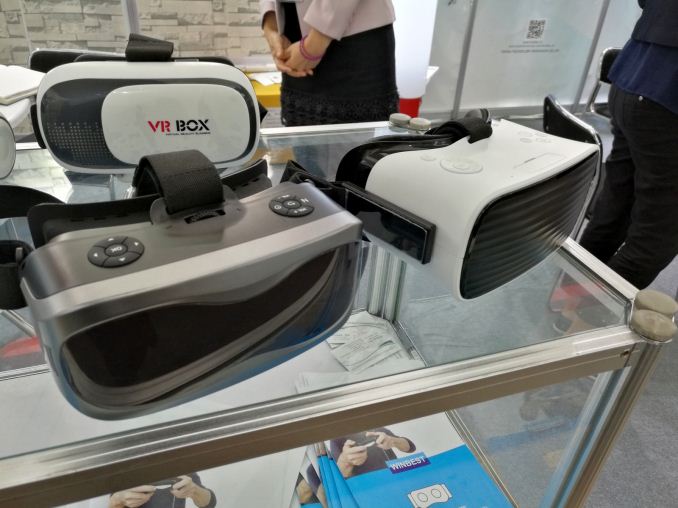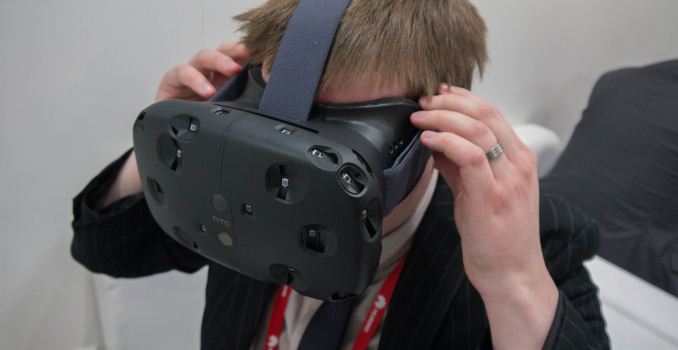IFA 2016: Examining the Malaise of Bargain Basement Virtual Reality
by Dr. Ian Cutress on September 9, 2016 9:00 AM EST
For the show this year, I left one day free just to roam freely around the show, looking for some insights or random bonus stories. One of the things that piqued my interest upon entering the International Tent was a number of VR headsets. It could be argued that the headsets that require a smartphone are a dime a dozen, so I scouted around for the VR headsets that were designed to come contained as all-in-one units and offer an untethered experience. A couple of the big names are touting untethered VR, so I asked around at a number of booths to look into the cheaper side of VR. For $100, you don’t get a lot.
For an all-in-one Virtual Reality headset, the core components include the screen resolution, screen size, screen quality, the SoC, the memory, the battery, the connectivity (wireless/LTE, USB etc.), the feel and the function of the headset are all key factors to get it right. In the myriad of six/seven headsets I was able to find in a morning at IDF, it was clear that almost all of these areas are gutted into the low-performance rung in order to meet very strict price points.
If we nostalgically look back to when Oculus was just starting, there were some clear defined goals that had to be achieved. For the most part they revolved around being to use the headset, eliminate nausea, and provide an immersive user experience. Millions of dollars and several prototypes later gave us the Rift, along with the Vive and other head-mounted displays (HMDs) that rely on a super powerful system behind it.
On the other side is Samsung Gear VR, leveraging an already owned premium smartphone with a reasonable element of a headset to house it – the smartphone is at a similar power budget to what you would expect to be the limit in front of the face. What these ‘bargain basement’ headsets try to do is try to provide all the hardware inside the headset, similar to the Gear VR, including SoC and battery and everything else, but for the same price as the Gear VR (minus smartphone). Of course, at the other end is Google Cardboard.
The true comparison points to these all-in-one VR systems could be the backpack VR units that house a laptop-like device, but these still require cables. The better comparison is to Intel’s Project Alloy, announced at IDF, or Qualcomm’s new VR820 platform, however both use internal and external cameras as part of a mixed VR/AR concept called mixed reality. We’ve seen other things like the SulonQ, which uses older AMD embedded parts, to provide the horsepower for an untethered VR experience as well. But all three of these are premium devices still in development. The goal of these cheaper headsets is to be super low cost, which also means there’s lots of competition to shave tenths of a cent off of the production costs.
As an additional caveat, the makers of these headsets I found on the show floor are the original design manufacturers, or ODMs. They are looking for bigger companies to order thousands of units and brand them under their own name, and subsequently deal with sales and distribution.












59 Comments
View All Comments
nathanddrews - Friday, September 9, 2016 - link
So if I had to summarize this article:At its best, VR is really expensive (headset/controller equipment + hardware to run it well) and mostly limited to rail-based shooter games, racing games, and flight sims... and anything less than that is basically not worth doing.
I've always love the idea of VR, but it's still too niche for me to invest in right now.
BugblatterIII - Friday, September 9, 2016 - link
That's not even close to the types of games and experiences that dominate the available content.VR's still finding its feet in terms of what genres port well and what new genres could be created, but the ones you've listed are perhaps the least suited to VR because they're mostly very nausea-inducing.
I agree that it's worth going the whole hog though. I had the Gear VR for years and now have the Vive, which is so far above the Gear it's a different species.
Mr Perfect - Friday, September 9, 2016 - link
It's the on-rails bit that kills it for me. Why can't they just have a thumstick on one of the hand held controllers to handle X Y movement? It's otherwise quite fun.prisonerX - Friday, September 9, 2016 - link
Because people don't want to throw up.theduckofdeath - Monday, September 12, 2016 - link
Yeah ,you need the movement sensors in the HMD or you shouldn't have any. Unless you have flawless hand to eye coordination that is, then a joystick can replace that. But, that person does not exist, I think. :Dmkozakewich - Monday, September 12, 2016 - link
From my experience playing Minecraft on the Rift DK1, it's not really the character movement that causes motion sickness. For me, it was the jittering when I turned my head. I eventually adapted to keeping my head still and using only the mouse to "turn" my head. The abstraction worked for me, because I'm used to playing video games, but I suppose one of the main draws of VR is in having that kind of control.So movement is possible, but you do need high frame-rates if you want to let players look around with their head without causing nausea.
sonicmerlin - Thursday, September 15, 2016 - link
You really think your experience applies when you've only tried the very first prototype?Flunk - Friday, September 9, 2016 - link
I suspect these headsets aren't designed for the US market, but rather the Chinese market, where the vast majority of customers couldn't possibly afford a Rift or Vive and the $2000 PC to power it.xype - Friday, September 9, 2016 - link
To be fair, I don’t know many people (I’m living western Europe) who can afford a Rift or Vive and the $2000 PC to power it, either. Or, those I do know, aren’t interested in the least—even though they would all classify as geeks. Sure, they’ll try it out at a show/convention, exclaiming "Neat!", but once the headset is off, "Not $3k neat, though…".sphigel - Friday, September 9, 2016 - link
If these "geeks" don't already own at least a good portion of the $2000 computer required for VR then they really aren't geeks are they? Most people interested in VR already have powerful gaming rigs. Yes, you might need a video card upgrade but that's about it. It's a bit disingenuous to say that VR costs $3k to get into.